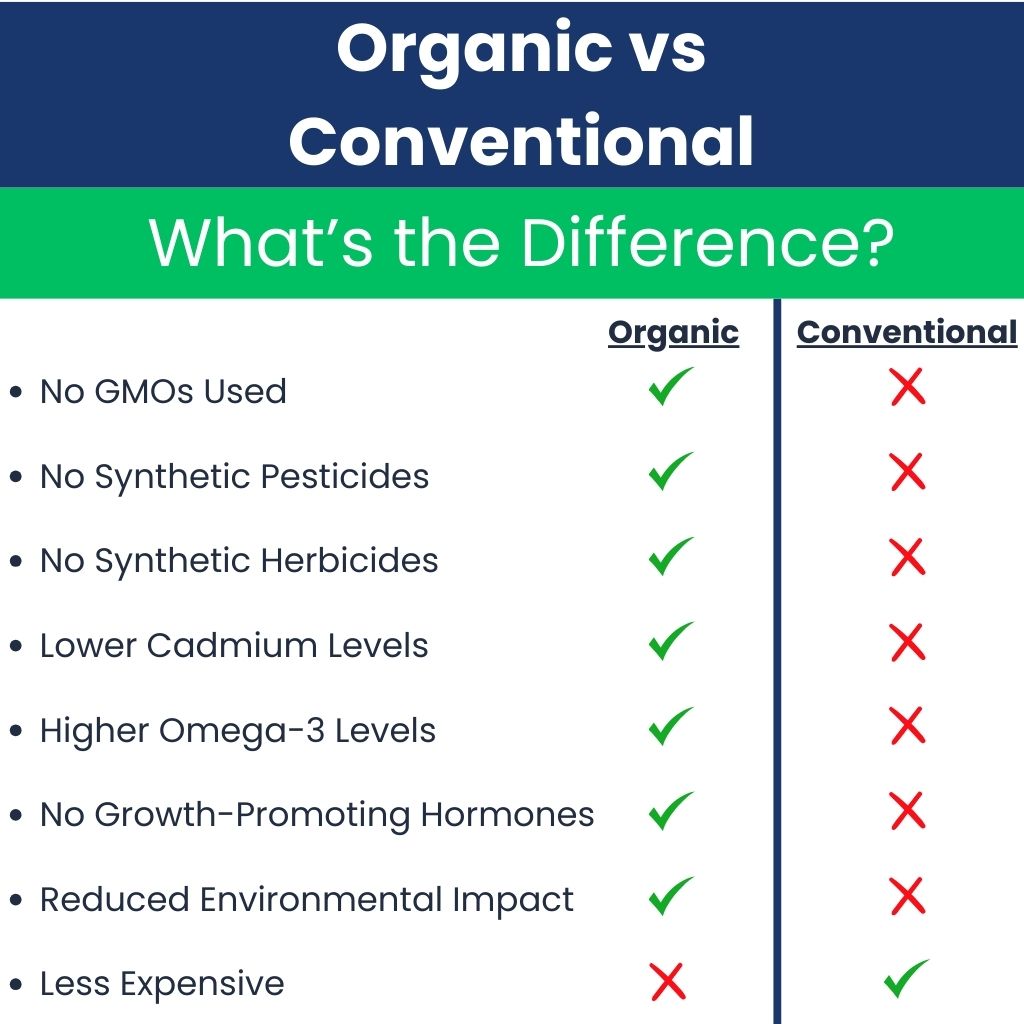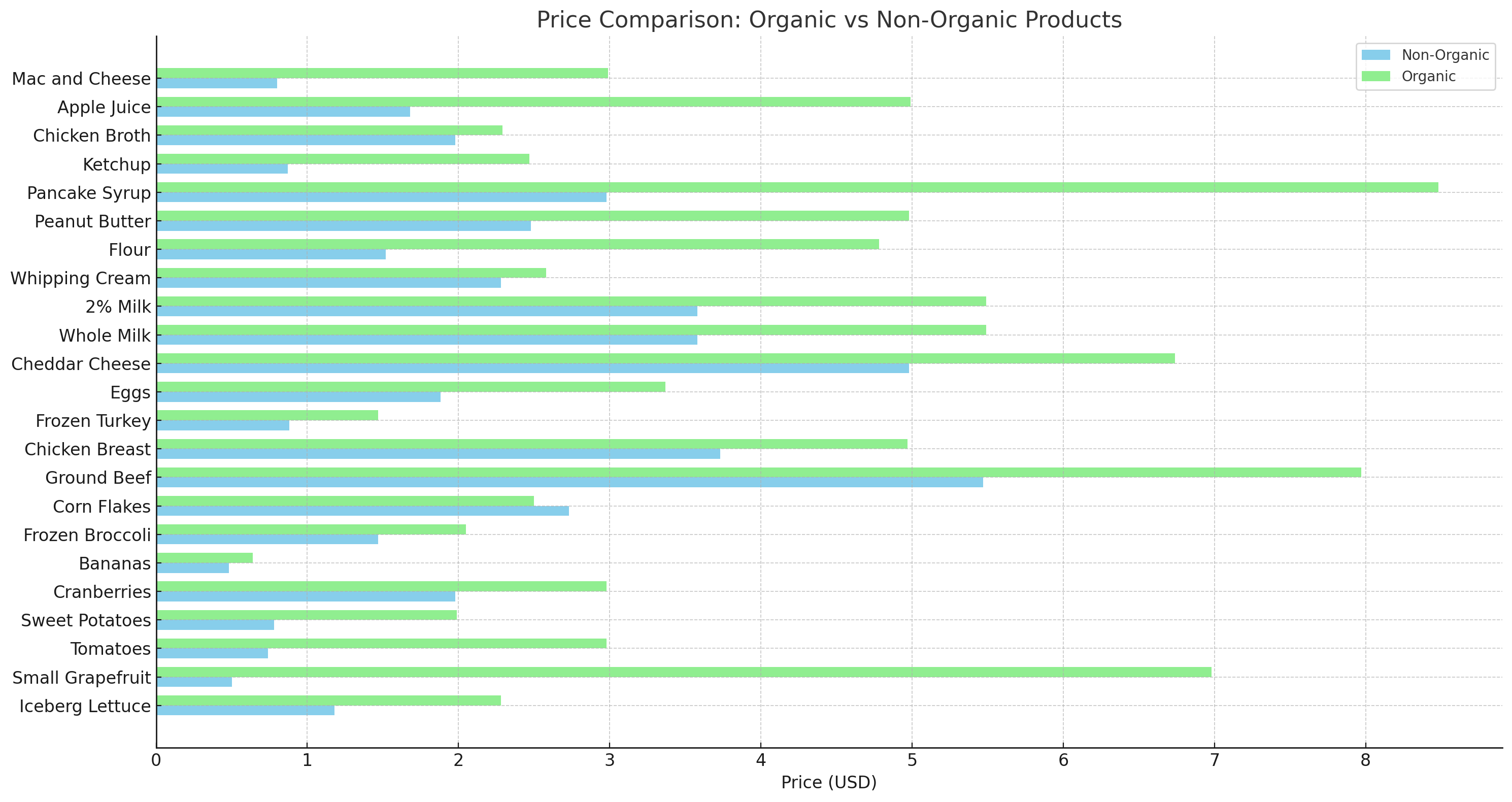.quote-container {
border: 2px solid #ccc;
border-left: 10px solid #d3a9e6;
padding: 10px;
margin: 0 auto;
border-radius: 5px;
max-width: 90%;
}
.quote-text {
margin: 0;
}
.quote-author {
text-align: right;
margin: 0;
}
Organic food is more than just a trend—it’s a lifestyle shift. With grocery shelves lined with organic labels and farmers’ markets flourishing, people everywhere are making the conscious choice to switch. Why? It’s simple: the way our food is grown matters for both our bodies and the planet  .
.
Recent studies have shown a direct link between organic eating and reduced pesticide levels in the body. But beyond this, there’s something deeper driving the shift—peace of mind. Consumers are increasingly valuing food free from synthetic chemicals, craving a connection to nature, and seeking long-term health benefits.
In this article, we explore exactly what happens when you make the switch to organic food and how your body begins to respond to the change.
The Science Behind Organic Eating
Take care of your body. It’s the only place you have to live. 
Organic farming promotes natural processes that maintain ecological balance and minimize the use of external synthetic inputs. Key practices include:
- Natural Fertilizers: Compost, animal manure, and cover crops replace synthetic fertilizers to enrich the soil organically.
- Biological Pest Control: Natural predators or beneficial insects manage pests instead of chemical pesticides, helping maintain ecosystem health.
- Crop Rotation and Diversity: Farmers grow a variety of crops sequentially to restore soil health, prevent disease, and minimize pest buildup.
- No Synthetic Inputs: Organic methods strictly prohibit GMOs, synthetic fertilizers, and pesticides, focusing instead on natural solutions.
- Sustainability and Biodiversity: Organic farms often prioritize biodiversity and adopt sustainable methods, like reduced tillage and agroforestry, to support healthy ecosystems.
Key Differences Between Organic and Conventional Foods
The differences between organic and conventional foods extend beyond farming practices, affecting several key areas:
 Organic food tends to offer higher levels of antioxidants and omega-3 fatty acids, although these benefits are not always consistent across studies.
Organic food tends to offer higher levels of antioxidants and omega-3 fatty acids, although these benefits are not always consistent across studies.  Conventional foods, including conventional meat products, may contain fewer of these nutrients, often due to grain-based feed used in livestock diets.
Conventional foods, including conventional meat products, may contain fewer of these nutrients, often due to grain-based feed used in livestock diets. Organic food carries significantly fewer pesticide residues, thanks to the exclusion of synthetic chemicals in its production, offering a safer option for those concerned about chemical exposure.
Organic food carries significantly fewer pesticide residues, thanks to the exclusion of synthetic chemicals in its production, offering a safer option for those concerned about chemical exposure.  Conventional foods, in contrast, often contain higher levels of pesticide residues due to reliance on synthetic pesticides for pest management.
Conventional foods, in contrast, often contain higher levels of pesticide residues due to reliance on synthetic pesticides for pest management. Conventional foods typically rely on monocultures and synthetic inputs, which can lead to soil depletion and water contamination over time. In contrast,
Conventional foods typically rely on monocultures and synthetic inputs, which can lead to soil depletion and water contamination over time. In contrast,  organic food is produced using practices like crop rotation and composting, fostering biodiversity and supporting long-term environmental health.
organic food is produced using practices like crop rotation and composting, fostering biodiversity and supporting long-term environmental health. Conventional foods may contain higher nitrate levels and antibiotic-resistant bacteria due to chemical fertilizers and antibiotic use in livestock.
Conventional foods may contain higher nitrate levels and antibiotic-resistant bacteria due to chemical fertilizers and antibiotic use in livestock.  Organic food, on the other hand, typically avoids these issues, providing a safer choice for consumers concerned about such risks.
Organic food, on the other hand, typically avoids these issues, providing a safer choice for consumers concerned about such risks.
What Happens to Your Body When You Switch to Organic
Switching to an organic diet can bring noticeable changes to your body, particularly by reducing your exposure to pesticides and promoting better health outcomes. Below is an overview of a relevant case study, the impact on pesticide levels, and potential long-term health effects.
Case Study: The Swedish Environmental Research Institute Experiment
The Swedish Environmental Research Institute conducted a study involving a family of five, tracking the effects of switching to a fully organic diet over three weeks.
In the first week, the family consumed their usual conventional diet, during which urine samples showed significant pesticide residues.
Once they transitioned to a 100% organic diet for two weeks, the pesticide levels in their bodies dropped dramatically—by nearly 89%.
This case highlights how even a short-term switch to organic food can significantly lower chemical exposure in the body.
Impact on Pesticide Levels
The Swedish study is not isolated. Other research supports that organic diets reduce exposure to pesticides like organophosphates, which are linked to developmental and neurological disorders.
The reduction in pesticide residues within just a week suggests that dietary choices directly impact chemical exposure, providing a safer, toxin-reduced environment for the body.
Effects on Long-Term Health and Well-Being
Switching to organic can contribute to long-term health benefits, although research is still ongoing. Organic foods tend to contain higher levels of bioactive compounds such as phenolics, which have been associated with anti-inflammatory and antioxidant properties.
There is also emerging evidence that organic food consumption may reduce oxidative stress, potentially lowering the risk of chronic diseases.
Furthermore, avoiding synthetic inputs like fertilizers and antibiotics in organic farming can reduce exposure to substances that may increase the risk of health issues over time, such as antibiotic-resistant bacteria or heavy metals like cadmium.
In summary, even brief exposure to an organic diet can lead to measurable reductions in pesticide levels, while the long-term consumption of organic foods holds promise for improved well-being through enhanced nutrient profiles and decreased chemical exposure.
Immediate Health Benefits of Eating Organic
- Reduced Pesticide Exposure
Organic foods contain fewer harmful chemicals like organophosphates, decreasing toxic exposure and minimizing health risks, particularly for children and pregnant women. - Improved Antioxidant Levels
Organic produce offers up to 69% higher antioxidant levels, including phenolics and flavonoids, which reduce inflammation and protect cells from oxidative stress. - Stronger Immune System and Less Antibiotic Resistance
Organic meat limits antibiotic use, reducing the risk of resistant bacteria and supporting better immune function for consumers. - Heart Health and CLA Benefits
Grass-fed organic meat and dairy provide healthier fats, like omega-3s and CLA, which help reduce inflammation, improve cholesterol, and support heart health.
How to Identify Organic Foods

To make sure you’re getting authentic organic products, here are some tips based on USDA regulations and common labeling practices:
1. Look for the USDA Organic Seal
The USDA Organic Seal is the most reliable indicator that a product meets national organic standards. These products must avoid synthetic pesticides, GMOs, antibiotics, and artificial fertilizers.
Anything carrying this seal has passed strict regulatory oversight by the USDA to ensure compliance with organic guidelines.
2. Understanding Labeling Terms
- 100% Organic: This label means every ingredient in the product is certified organic.
- Organic: Products with this label contain at least 95% organic ingredients.
- Made with Organic Ingredients: These products must have at least 70% organic content but do not qualify for the USDA Organic seal.
3. Check PLU Codes on Produce
When buying fresh produce, look for 5-digit PLU codes that begin with the number 9. For instance, organic bananas would typically carry a code like 94011.
Non-organic items, in contrast, have 4-digit codes starting with 3 or 4.
4. Find Dedicated Organic Sections in Stores
Most supermarkets organize organic foods into specific sections, making it easier to find certified options for produce, packaged foods, and dairy.
What Justifies Organic Food According to the USDA?
The USDA’s National Organic Program (NOP) outlines strict rules for what can be labeled as organic. This includes:
- Prohibiting the use of synthetic pesticides, fertilizers, and GMOs in crop production.
- Limiting the use of antibiotics and hormones in animal farming, ensuring better animal welfare and food safety.
- Enforcing soil and environmental health practices like crop rotation, composting, and conservation of biodiversity.
- Stringent inspections and traceability standards throughout the supply chain, ensuring consistent quality from farm to shelf.
Nutritional Comparisons: Organic vs Conventional

Vitamins and Minerals
- Organic Crops: Studies have shown that organic fruits and vegetables tend to contain higher levels of vitamins and minerals, such as vitamin C, magnesium, phosphorus, and iron. Organic foods are also associated with lower nitrate levels, which can benefit overall health by reducing the risks linked with excessive nitrate intake.
- Conventional Crops: In some cases, conventional produce may offer higher levels of certain minerals like iodine and selenium, particularly in dairy products, due to fortified feeds and agricultural practices. This is particularly important in regions where iodine deficiency is a concern.
Omega-3 Fatty Acids in Dairy and Meat
- Organic Dairy and Meat: Organic milk and meat contain approximately 50% more omega-3 fatty acids compared to conventional products. These beneficial fats support heart health, reduce inflammation, and improve neurological function. The elevated omega-3 levels in organic products are largely attributed to the animals’ grass-fed diets and organic feeding practices.
- Health Benefits: A switch to organic dairy and meat could positively impact health by improving the omega-6 to omega-3 ratio, which is essential for reducing chronic inflammation and promoting cardiovascular health. Organic milk also contains higher levels of conjugated linoleic acid (CLA), known for its protective effects against heart disease.
Challenges and Considerations
Cost and Accessibility of Organic Foods

Average Organic vs Non-Organic Price Comparison
Organic foods often come with higher price tags due to labor-intensive farming practices, smaller-scale production, and stricter regulatory standards involved.
These costs make organic foods less accessible, especially for low-income households or those living in areas with limited availability of organic products in supermarkets.
Strategies for Making Organic Eating Affordable
To offset the higher costs, consider the following strategies:
- Prioritize Purchases: Focus on buying organic versions of the produce items listed on the Environmental Working Group’s (EWG) Dirty Dozen list, which contain the highest levels of pesticide residues when grown conventionally.
- Buy in Bulk and Seasonally: Purchasing seasonal organic produce in bulk can help reduce prices. Farmers’ markets often offer seasonal discounts, and some local co-ops provide bulk buying options.
- Use Coupons and Discounts: Some organic brands and local stores offer promotional discounts or memberships for frequent buyers. Subscribing to newsletters from organic food providers can keep you updated on special deals.
The EWG Dirty Dozen List
The EWG Dirty Dozen List for 2024 identifies 12 fruits and vegetables with the highest pesticide residues, encouraging consumers to buy organic versions of these items to reduce exposure.
Commonly listed items include strawberries, spinach, apples, and grapes. By focusing on these foods, consumers can make strategic choices without committing to a fully organic diet, balancing cost with health benefits.
Frequently Asked Questions
1. Does Organic Food Help with Weight Loss?
Organic foods themselves don’t guarantee weight loss, but those who consume organic products tend to lead healthier lifestyles overall. Research indicates that organic consumers often eat more fruits, vegetables, and whole grains while being more physically active—factors that contribute to better weight management. This connection is more about behavior patterns than a direct result of the organic label itself.
2. Are Organic Foods Safer for Pregnant Women?
Yes, organic foods can provide benefits for pregnant women by reducing exposure to synthetic pesticides, which may affect fetal development. Organic diets can help lower the risk of consuming pesticide residues found in conventional produce, supporting a safer pregnancy.
4. Can Organic Foods Reduce the Risk of Chronic Diseases?
Preliminary research suggests organic foods, which tend to contain fewer pesticide residues and higher antioxidant levels, may help reduce the risks of chronic diseases like obesity, diabetes, and certain cancers. While more research is needed, switching to organic can be a precautionary approach to lowering pesticide exposure and potentially improving long-term health outcomes.
Final Thoughts: Is Organic Worth It?
Organic eating is about investing in long-term health and sustainability, though it can be pricier.
Balancing costs by focusing on high-pesticide produce from the Dirty Dozen list and buying non-organic where it’s safer helps manage budgets.
Every small organic swap supports better well-being and eco-friendly practices. Start small and build organically—literally! Remember: It’s not about perfection but finding what works for you.
After all, life’s too short to stress over pesticides when you could be enjoying a delicious organic strawberry. 

The post What Happens When You Eat Organic Food: Facts & Benefits appeared first on Power of Positivity: Positive Thinking & Attitude.





 Organic food tends to offer higher levels of antioxidants and
Organic food tends to offer higher levels of antioxidants and  Conventional foods, including
Conventional foods, including  Organic food carries significantly fewer pesticide residues, thanks to the exclusion of synthetic chemicals in its production, offering a safer option for those concerned about chemical exposure.
Organic food carries significantly fewer pesticide residues, thanks to the exclusion of synthetic chemicals in its production, offering a safer option for those concerned about chemical exposure.  Conventional foods, in contrast, often contain higher levels of pesticide residues due to reliance on synthetic pesticides for pest management.
Conventional foods, in contrast, often contain higher levels of pesticide residues due to reliance on synthetic pesticides for pest management. Conventional foods typically rely on monocultures and synthetic inputs, which can lead to soil depletion and water contamination over time. In contrast,
Conventional foods typically rely on monocultures and synthetic inputs, which can lead to soil depletion and water contamination over time. In contrast,  organic food is produced using practices like
organic food is produced using practices like  Conventional foods may contain higher nitrate levels and antibiotic-resistant bacteria due to
Conventional foods may contain higher nitrate levels and antibiotic-resistant bacteria due to  Organic food, on the other hand, typically avoids these issues, providing a safer choice for consumers concerned about such risks.
Organic food, on the other hand, typically avoids these issues, providing a safer choice for consumers concerned about such risks.
